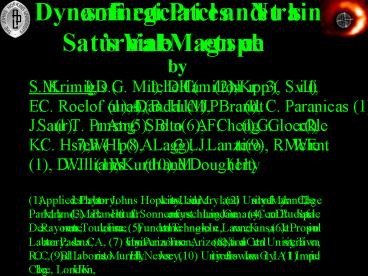Dynamics of Energetic and Neutral Particles... PowerPoint PPT Presentation
Title: Dynamics of Energetic and Neutral Particles...
1
(No Transcript)
2
ENA generation mechnism
Krimigis et al, 2004
3
Some Questions about the Interaction between
Trapped Particles and Neutrals
- What is the source of trapped particles?
- How are they accelerated to high energies?
- What is the principal loss mechanism?
- How do particles respond in the rotating magnetic
field of Saturn? - Are particle collisions with ring and icy moon
surfaces important?
4
Rev 0
5
Charge Energy Mass Spectrometer (CHEMS) on
Cassini records fingerprints of ion composition
at Earth, Jupiter, and Saturn
Saturn
Earth
Jupiter
mass (amu)
Plotted 2/25/05
mass per charge (amu/e)
6
Some Questions about the Interaction between
Trapped Particles and Neutrals
- What is the source of trapped particles?
- How are they accelerated to high energies?
- What is the principal loss mechanism?
- How do particles respond in the rotating magnetic
field of Saturn? - Are particle collisions with ring and icy moon
surfaces important?
7
Energetic Neutral Atom (ENA) Imaging Ofast H ?
Ofast H
ENA generation mechnism
8
Grid outlines INCA FOV
9
ENA PERIODICITIES
Hydrogen
ENA emission modulated at Saturns rotation period
Oxygen
10
With what else does this ENA oscillation
correlate?
B-field
SKR
Energetic (25-200keV) e-
11
(No Transcript)
12
7 Rs
At what radial distance is the corotating ENA
emission concentrated?
13
(No Transcript)
14
(No Transcript)
15
The density of OH in the 6-10 Rs region is
comparable to H density in the Geocorona. O is
probably about the same as OH. O lifetime in
the Earths ring current is 8h. O lifetime in
the inner Saturn magnetosphere could be much
shorter, depending on its radial placement (O, OH
charge-exchange cross-section is larger than H)
Highest ENA production
Devoid of energetic ions
16
Modulation persistence and phase lock suggest an
active longitude (could be a quadrant) coupled
with a preferred local time for ion injection
(Mauk et al, GRL, June 2005)
17
Modulation persistence and phase lock suggest an
active longitude (could be a quadrant) coupled
with a preferred local time for ion injection
18
Modulation persistence and phase lock suggest an
active longitude (could be a quadrant) coupled
with a preferred local time for ion injection
19
Modulation persistence and phase lock suggest an
active longitude (could be a quadrant) coupled
with a preferred local time for ion injection
20
Modulation persistence and phase lock suggest an
active longitude (could be a quadrant) coupled
with a preferred local time for ion injection
21
Modulation persistence and phase lock suggest an
active longitude (could be a quadrant) coupled
with a preferred local time for ion injection
22
Modulation persistence and phase lock suggest an
active longitude (could be a quadrant) coupled
with a preferred local time for ion injection
23
Modulation persistence and phase lock suggest an
active longitude (could be a quadrant) coupled
with a preferred local time for ion injection
24
Modulation persistence and phase lock suggest an
active longitude (could be a quadrant) coupled
with a preferred local time for ion injection
25
Modulation persistence and phase lock suggest an
active longitude (could be a quadrant) coupled
with a preferred local time for ion injection
26
Modulation persistence and phase lock suggest an
active longitude (could be a quadrant) coupled
with a preferred local time for ion injection
27
How do these events look from an off-equatorial
vantage point?
28
Same event, higher energy H
29
Watch the rotating blob
30
Summary of Observations on Periodicities
- Brightest ENA emission from interface between
dense gas cloud in vicinity of E-Ring, and
energetic ions just outside that region. - Large scale ion injections are commonly seen as
corotating brightenings in ENA. - Ion injections are well correlated with SKR,
including when they are seen repeating at
Saturns rotational period. - Oxygen ENA emission shows more pronounced, and
more regular, rotation modulation than hydrogen. - Energetic oxygen lifetime in the inner
magnetosphere should be no longer than hours,
given the density of the water-product cloud in
the vicinity of the E-ring. The repeated,
un-damped rotational modulation therefore
requires nearly continual replenishment of the
energetic oxygen ions. - The synchronicity of the modulated ENA emission,
as well as the unchanging energy dispersion,
requires repeated injections preferentially at
the same Saturn IAU longitude --possibly the same
clock that drives the SKR.

